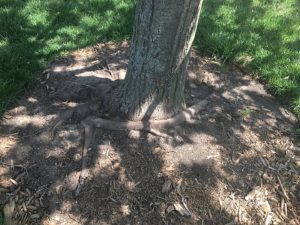Roots are the lifeline of a tree, vital to its health and well-being. The root system’s main job is to absorb and transport much-needed water, nutrients and oxygen. It’s also responsible for helping to stabilize the structure of the tree, keeping it healthy and strong.
Most trees’ root systems expand well beyond the base of the tree trunk. In fact, if you look at the top of your tree, notice the branches that have grown the farthest away from the trunk (called the dripline). In most cases, your tree roots extend underground that far out as well.
However, a number of issues can impact the function of the tree’s root system, causing damage to the tree, its ability to absorb the food it needs to survive, and even causing it to die.
Symptoms to look for in a tree that is in trouble include wilting or curling leaves, leaves that prematurely drop before fall, the sudden onset of dead branches, or the plant slowly dying off. There could be several reasons this is happening, including disease or a pest infestation, but the problem could also be happening well below the surface of the soil. In each of these instances, it’s best to call in the experts.
Root Rot
When a tree or shrub is planted in an area that receives an abundance of water, whether due to overwatering or drainage issues, such as an improper grade in the landscape, or it’s been planted near a downspout, the plant’s root system could literally be drowning. If the plant is consistently in standing water, the roots never have a chance to dry out completely. Too much moisture also prevents the roots from absorbing oxygen and nutrients. And if the roots are constantly wet, it will cause the root system to rot.
Though it’s normal for fungus to be found in the soil, too much water invites the fungus to become active, spreading to the entire root system and eventually damaging the plant. For example, Armillaria is a fungus that infects many deciduous trees (those that lose their leaves in the fall) and evergreen trees and shrubs. The fungus causes decay to the roots and lower part of the plant’s trunk, making it unstable and hazardous in heavy winds and storms. Another type of fungus is Tomentosus, which primarily impacts evergreen trees. This fungus enters through the base or the wound of a tree, causing it to become unstable and, eventually, to die off.
Poor drainage in your landscape can be corrected. When you contact us, we will not only evaluate the drainage issues you’re experiencing but assess any damage to your tree’s root systems.
Girdling
Girdling refers to a situation where the roots of a tree twist themselves around the base of the plant instead of growing outward. In this situation, the roots grow tighter and tighter around the plant’s base, cutting off its supply of nutrients and water and girdling the trunk.

Girdling happens for several reasons, but an improperly planted tree is the most common. For example, trees that are planted in patio containers can experience girdling as the roots don’t grow outward but are restricted within the pot and grow around the base of the plant. Another reason can be that the hole the tree was planted in is too small, the burlap was left on the root ball, or additional debris was left in the hole where the tree was planted, restricting the root growth. Another contributing factor can be the soil. If it’s very compact, the roots can’t penetrate it. So instead of growing outward, they grow where they can and in the only space available, around the base of the tree.
Girdling roots can be resolved if handled by a professional. If you can see beneath the tree’s surface that the roots are beginning to girdle, or if the tree is exhibiting any issues with lack of growth, premature leaf drop, or dead branches that suddenly appear, contact us to have it evaluated.

